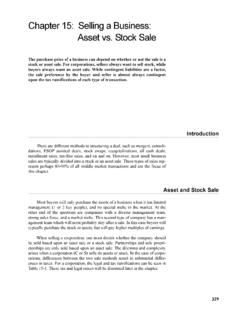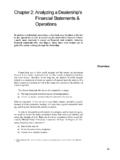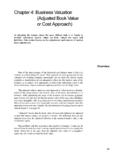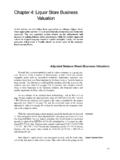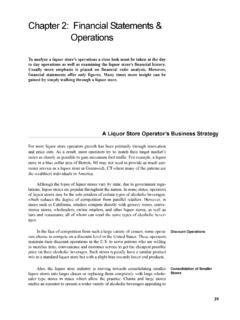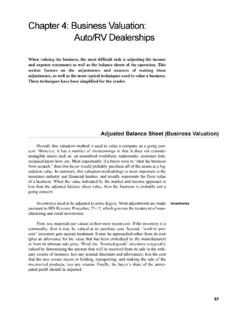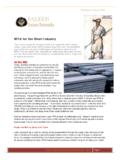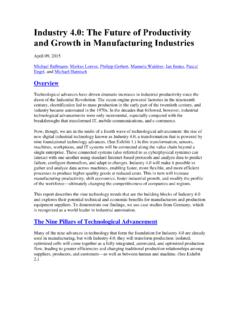Transcription of Chapter 1: Overview of the Liquor Store Industry
1 Chapter 1: Overview of the Liquor Store Industry A macro Overview of the Liquor Industry and the economy are critical starting points for any valuation analysis. In many cases, the Liquor Store Industry trends are better indications of the future than a review of the company's historical operations. History The Liquor Store Industry has undergone many changes throughout its his- tory. The strictest period for the Liquor Store Industry in the United States was during the Prohibition Era which lasted from 1919 through 1933. During Prohi- bition, the sale and consumption of alcohol were completely outlawed and stores were forced to close down.
2 After Prohibition, state control was returned, which led to varying prices and competition levels per state. Taxation plays a large role in many states, while others choose not to tax alcohol. States also have a strong role in regulating production, distribution, and the sale of alcohol. In 1978 many states chose to deregulate Liquor prices, thereby allowing supermarkets and convenience stores to enter the market and compete. In response to this, independent Liquor stores lobbied to sell small food items and other miscellaneous items. In 1996, the Joint Committee of the Department of Health and Human Services and the Department of Agriculture issued dietary guidelines indicating that moderate consumption of alcohol could be beneficial to one's health.
3 Other studies were published thereafter, which furthered the notion that drinking in moderation could lead to health benefits. Furthermore, a lift of a self-imposed ban on advertising among distilleries in 1996 helped increase earnings for Liquor stores . Today, Liquor stores are facing competition from a variety of sources, as well as scrutiny from local residences within their respective areas. However, Liquor stores still compose 60 percent of the Liquor 1. Encyclopedia of American Industries, 2007. 13. Overview of the Liquor Store Industry Industry Snapshot As of 2005, according to the Census Bureau, the beer, wine, and Liquor Store Industry included 33,415 Liquor stores throughout the United States, while employing an estimated 136,350 Together, the cumulative revenues of the beer, wine, and Liquor Store Industry total over $30 billion.
4 Liquor stores alone account for $ billion which can be broken down into: $ billion for beer $ billion for spirits, and $ billion for The average revenue per Store , as of 2008, is $400,000. No major companies dominate a significant portion of the Industry due to varying regulation by state governments. The top 50 companies combined only form less than 20 percent of the sales in the United The heavy fragmentation leaves room for competition among mom-and- pop type Liquor stores . However, in recent years, with lobbying of local gov- ernment agencies, there have been efforts to legalize the formation of chain Liquor stores , which will further pressure independent retailers.
5 In California, where multiple licenses can be issued, Beverages and More (BevMo!), which currently (2008) operates 64 stores in the state, has grown at a pace of roughly 17% over the past ten years. Other operators, such as Wal-Mart, have begun to enter the market as well, creating more competition as well as shifting the Industry dynamics. Industry Profile Industry Makeup The Liquor Store Industry is composed of independent stores , local chains, state-run outlets, and large wholesaler type stores . The independent stores , mom-and-pop type stores , are typically small (from a thousand to a few thousand square feet) and serve the local area.
6 They typically generate revenues of less than $1 million annually with an average of $400,000 per Store . These stores also average $200,000 in revenues per worker. In some states, an independent Store may sell items on behalf of the state and work on commission. Recently, the Industry has begun shifting from the small, independently run stores (mom and pop) to large superstores or wholesalers. These stores stock a 1. Encyclopedia of American Industries, 2007. 2. Encyclopedia of American Industries, 2007. 3. Hoovers: Beer, Wine, and Liquor stores Overview 14.
7 Overview of the Liquor Store Industry wide variety of beverages and can be as large as 50,000 square feet or larger and can generate between $1 and $5 million in revenues or more, depending on area. Larger stores can average $800,000 in revenues per worker. These superstores are usually located in shopping centers, where they can receive maximum expo- sure and a high traffic volume. State laws may control or limit inventory selection by regulating the types of alcohol sold. In several states, Liquor stores cannot sell beer, while grocery stores are limited to only selling beer and wine (see Table 1-12 on page 36 for a state by state usage and distribution chart, which shows what types of alcoholic beverages can be sold by a given outlet.)
8 Distributors often limit inventory selec- tion in control states, as well as the products they choose to stock. For popular, high-end products, demand may exceed supply, and stores receive limited allo- cations. These distributors have relationships with alcohol suppliers and will sometimes push to get those products into the market. Liquor stores may specialize in a beverage type such as wine, in which it may carry a few thousand brands, while a Liquor superstore may offer between 20,000 and 70,000 different alcoholic beverages. There are several organizations for the Liquor Store Industry as well as the Organizations alcoholic beverage Industry as a whole.
9 The Distilled Spirits Council (DIS- CUS) is one of the largest national trade associations, which represents nearly 80% of all distilled spirits brands sold in the United States. The organization is proactive on policy and legislation in the nation's capital, state capitals, and for- eign capitals worldwide. They also employ a team of economists, scientists, lob- byists and public affairs professionals to increase adult market access for spirits products, and to allow greater convenience and choices for the adult consumer. The council also takes an active role in preventing higher taxes and barriers to trade.
10 Another association, formed in 2002 through the merger of the National Beverage Retailers (NABR) and the National Licensed Beverage Associa- tion (NLBA), called the American Beverage Licensees (ABL) represents off- premise licensees in the open or license states and on-premise proprietors in markets across the nation. Most of the 18,000 members are independent family owned operators and small business owners. ABL keeps track of legislation and Industry trends and works with other Industry groups toward the responsible sale of alcoholic products in order to protect the small business owners.

